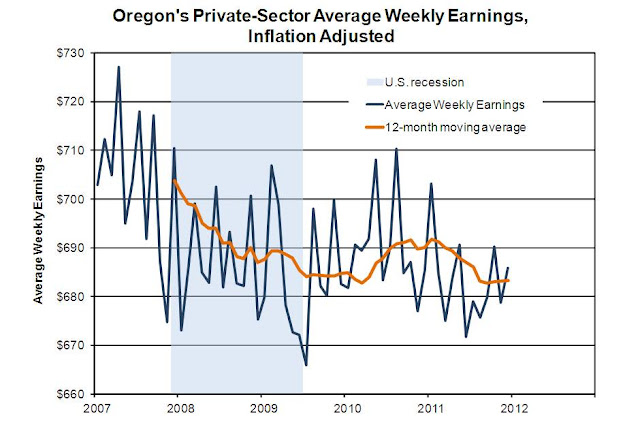Between 2007 and 2011, inflation rose by about 8 percent for all urban consumers in the Portland-Salem area. So, a worker would need to earn 8 percent more in 2011 than in 2007 just to keep up with the rising costs of goods and services.
After adjusting for inflation, Oregon's average private-sector wages were between about $680 and $690 per week (12-month moving average) from most of 2008 through early 2012. During 2007, average wages were $10 to $15 higher per week. Many factors are at play behind the trend: changes in the duration of the workweek; shifts in industry employment; and other changes in the composition of the workforce. Still, it seems clear that the real wages of Oregon workers haven't advanced in recent years. This chart shows average weekly earnings adjusted to 2007 dollars.
A recent article from the Wall Street Journal picks up on lagging wage growth nationwide, but focuses on manufacturing. The article claims that the lack of growth in inflation-adjusted wages is a key factor contributing to the rebounding competitiveness in U.S. manufacturing. Reasons include wage growth in lower-wage countries that compete with the U.S., and high domestic unemployment which has prompted negotiations that restrain or reduce wages and benefits. Some U.S. manufacturers have negotiated two-tier contracts that allow new hires to be paid less than existing starting wages.
The story notes that earnings for production and other nonsupervisory
workers in manufacturing averaged $19.15 an hour in April, where they were in 2000 (adjusted for inflation). By comparison, average hourly earnings for all private-sector production and
nonsupervisory workers rose by 5.3 percent to $19.72
since 2000. Averages don't account for change in the industry over time, and wage measures don't count costs for health and retirement benefits. So the Employer Cost Index, which includes benefits
and is adjusted for the changing mix of occupations and industries, was also examined. It shows that, adjusted for inflation, manufacturers' labor costs were 2.7 percent
lower in the first quarter of 2012 than in 2005, when the economy was
stronger and unemployment was lower. For public and private civilian employers of all sorts, labor costs were basically flat—down 0.3 percent.

No comments:
Post a Comment